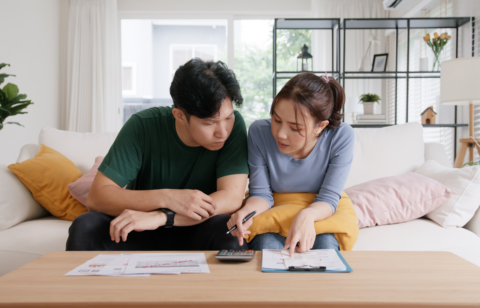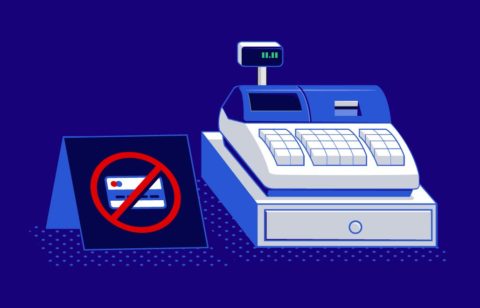Millions of Americans are drowning in red ink. Is the answer to their troubles a willingness to take on new debt?
It might sound crazy, but there are times when signing up for new debt — in the form of a personal loan — might be a way to begin the journey out of a giant financial hole, says Stephanie Yates, interim chair of accounting and finance in the University of Alabama at Birmingham’s Collat School of Business.
In this strategy, you take out a personal loan large enough to pay off your credit card debt entirely. At that point, the credit card debt disappears, and you’re left to pay off the new debt on your personal loan.
“This would be a reasonable strategy if the terms on the loan are better than those on the credit card,” says Yates, who is also director of the UAB Regions Institute for Financial Education.
Good Debt vs. Bad Debt
Americans are no strangers to credit card debt. U.S. households held an average of around $5,300 of such obligations at the end of 2020, according to Experian, one of the “big three” credit-reporting agencies.
Yates says most debts fall into one of two categories: good debt and bad debt.
Determining which type of debt you hold is based on “the useful life of the item purchased compared to the length of the debt,” Yates says.
For example, borrowing to purchase long-lived assets that will be paid off within their useful lifetime — including homes, businesses, and higher education — is considered good debt. While these debts can be costly in the short run, they promise long-term rewards in the form of a brighter financial future.
“Bad debt would then be the opposite,” Yates says. Generally, these are debts for items that don’t grow in value, and where you’re making payments at a high-interest rate for a long period of time. Typically, credit card debt is considered “bad” debt, because it often comes with a high annual percentage rate and can be expensive to pay down.
In many cases, personal loan debt also can fall into the “bad” category. However, it can be transformed into “good” debt – or at least “better” debt — if you use the personal loan to achieve financial freedom and pay off credit card debt. This is only true when the personal loan’s terms — such as interest rate and length of the Term — are better than the terms on the credit card you’re trying to pay down.
When Does It Make Sense to Use a Personal Loan to Pay Off Credit Card Debt?
“A personal loan at a lower interest rate than the credit card rate would be a good choice, with all other factors held constant,” Yates says.
Let’s say Wells Fargo is advertising personal loan rates that begin at 5.74% for a $10,000 loan over a three-year term. If you currently have $10,000 in credit card debt at the current average credit card rate – which LendingTree says is 19.49% — using a personal loan to pay off your credit card debt might save you a bundle in interest costs.
But not everybody qualifies for a personal loan at such great rates. That is particularly true if your credit history is shaky, and you have a low credit score.
If you can’t get the best terms, a personal loan might not save you much (or any) money compared to what you would pay if you left the debt on the credit card.
Many companies that offer personal loans attach a wide range of interest rates to these products. Depending on your credit history and other factors, your interest rate could be as low as 6% or as high as nearly 20%.
Disadvantages of a Personal Loan
Even if you do qualify for a great rate, some personal loans charge origination fees in the neighborhood of 1% to 6%. Others charge you prepayment fees if you try to pay off the balance early. If you have an especially long repayment period, you might end up paying more interest rate costs over the life of the loan than if you had left the debt on your credit card.
In addition, your monthly personal loan payment is likely to be higher than the minimum payment you are required to make on your credit card. Having a higher monthly payment can make life difficult if cash is especially tight.
So, before you take the plunge and decide to use a personal loan to achieve credit card debt relief, make sure you fully understand the personal loan’s terms. “It is important for consumers to do their research,” Yates says
She says some key factors that can determine if this is the right strategy for you include:
- The interest rate of your existing debt
- The interest rate of the personal loan
- The number of payment periods
- The amount of the payment you will owe each month
After carefully weighing all these factors, you might find that a personal loan makes sense as a way to pay off your credit card debt.
However, if the number of payment periods and resulting monthly payments would create a cash flow crunch, “the consumer may want to think again,” Yates says.
Tips for Getting the Best Loan Terms
The ability to get great loan terms will help you decide if taking out a personal loan is the right strategy for you.
Yates notes that having a longstanding relationship with a financial institution can help you get the loan approved, and at the best terms.
Establishing a relationship with a financial institution and using it for multiple products — such as checking accounts, savings accounts, credit cards, and loans — helps you establish a track record with a bank or credit union. “That may result in lower rates and fees,” Yates says.
For example, Wells Fargo notes that it offers a “relationship discount” of 0.25% to customers who have a qualifying Wells Fargo consumer checking account and make automatic payments from a Wells Fargo deposit account.
“Also, do not be afraid to look beyond the big banks when searching for the best personal loan terms,” Yates says.
“Credit unions traditionally provide competitive rates to members compared to commercial banks,” she adds.
Alternatives to Using a Personal Loan to Pay Off Debt
Of course, a personal loan might not be your best option for paying down credit card debt. Like credit cards, personal loans are unsecured debt. That means they tend to have higher interest rates than loans backed by collateral, such as your home.
Using a home equity loan or home line of credit (HELOC) to pay off your debt is another option. You’re likely to get a better interest rate on a home equity product because your home is used as collateral on the debt. The risk: Using a home equity loan or HELOC to pay off credit card debt puts your home at risk should you fail to make payments.
You may also want to consider credit cards that have 0% balance-transfer offers. This can allow you to transfer your existing debt to a new credit card with no interest on the debt for a period — possibly as long as 20 months. This can buy you time to pay down the debt inexpensively. The risk: If you fail to pay down all of your debt before a 0% balance transfer period expires, the interest costs on your remaining debt could skyrocket.
Whatever route you choose, make sure you’re paying down your obligations as much as possible, and not simply shuffling debt from one place to another. Many experts suggest that using one form of debt to pay off another form of debt does not get at the root of your spending problem.
“If a consumer is interested in aggressively working toward retiring consumer debt, it is best to develop a debt repayment plan,” Yates says.
To start such a plan, review your budget to determine how much you can afford to allocate toward paying down the debt over and above your minimum payments. Then, determine how you’ll use those payments to pay down your debt. Yates says options include:
- Focusing on the debt with the highest interest rate, and paying off your most costly debt first
- Paying off the debt with the lowest balance and then moving to the debt with the next lowest balance — the so-called “snowball” method that helps you build momentum by paying off one debt after another
- Paying off the cards with the highest utilization ratio. This ratio is the amount of debt you owe compared to the amount of debt available to you in the form of credit. Lowering this ratio can help boost your credit score.
Once you’ve paid off the debt, don’t fall back into bad habits. Instead, concentrate on developing better credit card habits. “Strive to be a ‘convenience’ user instead of a ‘revolving’ user by paying off balances each month”, Yates says.
At National Debt Relief, we take pride in empowering people to regain their financial stability through our proven debt relief program. Contact us and talk to a financial expert who will work with you to find the best option to settle your debt and help you achieve financial independence.







